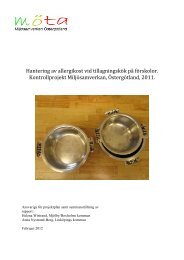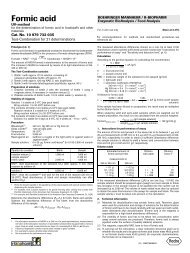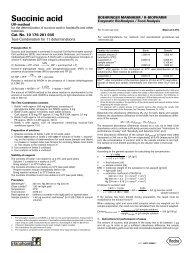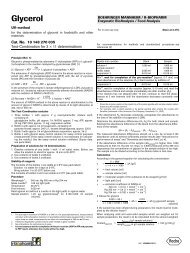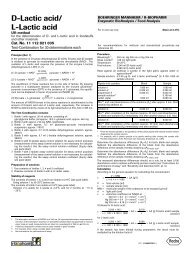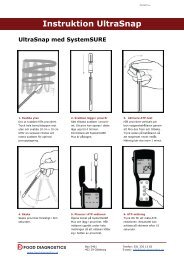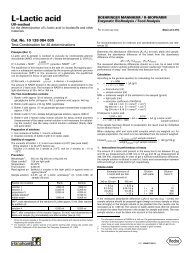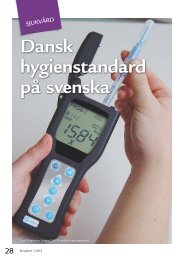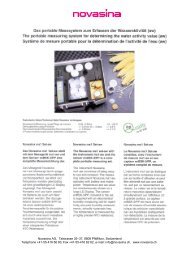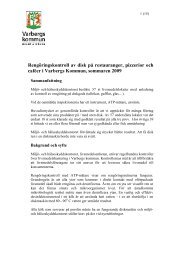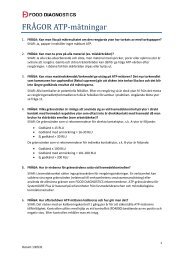Nitrate (NO 3 ) - Food Diagnostics
Nitrate (NO 3 ) - Food Diagnostics
Nitrate (NO 3 ) - Food Diagnostics
You also want an ePaper? Increase the reach of your titles
YUMPU automatically turns print PDFs into web optimized ePapers that Google loves.
13. Reference for application in the colorimetric method for the determination of<br />
nitrate and nitrite in sausages/meat products acc. to Arneth (s. Ref. 1.1)*<br />
Principle (Ref. 1.1)<br />
<strong>Nitrate</strong> is reduced by reduced nicotinamide-adenine dinucleotide phosphate<br />
(NADPH) to nitrite in the presence of the enzyme nitrate reductase (NR) (1).<br />
<strong>Nitrate</strong> + NADPH + H +<br />
NR<br />
nitrite + NADP + + H 2 O<br />
Nitrite reacts with sulfanilamide and N-(1-naphthyl)-ethylenediammonium<br />
dichloride with the formation of a red diazo-dyestuff (2).<br />
(2) Nitrite + sulfanilamide + N-(1-naphthyl)-ethylenediamine<br />
diazo-dye<br />
The amount of the diazo-dyestuff formed during the reaction is stoichiometric<br />
to the amount of nitrite. The dyestuff is measured by means of its light<br />
absorbance at 540 nm (Hg 546 nm) in the visible range.<br />
Reagents<br />
I. Dissolve 0.2 g bromothymol blue in 100 ml methylated ethanol (96 %;<br />
w/w).<br />
II. Carrez-I-solution: 150 g K 4 [Fe(CN) 6 ] × 3 H 2 O/l redist. water.<br />
III. Carrez-Il-solution: 230 g Zn(CH 3 COO) 2 × 2 H 2 O/l redist. water.<br />
IV. Use the contents of bottle 1 (imidazol buffer, pH approx. 7.8) of the<br />
Test-Combination <strong>Nitrate</strong> undiluted.<br />
The solution is sufficient for approx. 36 assays.<br />
The solution is stable at 2–8°C (see pack label).<br />
V. Use the tablets from bottle 2 (NADPH, FAD) of the Test-Combination<br />
<strong>Nitrate</strong> unchanged.<br />
The tablets are sufficient for approx. 36 assays.<br />
The tablets are stable at 2–8°C (see pack label).<br />
VI. Use the contents of bottle 3 (nitrate reductase) of the Test-Combination<br />
<strong>Nitrate</strong> unchanged.<br />
Each bottle contains sufficient enzyme for approx. 12 assays.<br />
The contents of bottle 3 are stable at 2–8°C (see pack label).<br />
VII. Buffer/enzyme solution<br />
Dissolve the contents of one bottle 3 of the Test-Combination <strong>Nitrate</strong><br />
with 12 ml imidazole buffer solution (IV) from bottle 1 of the Test-Combination<br />
<strong>Nitrate</strong>, add 50 mg Titriplex III (di-sodium-ethylen-dinitrilotetraacetate-dihydrate)<br />
and mix.<br />
Prepare the solution freshly before use.<br />
VIII.Color reagent<br />
Solution A: Dissolve 8 g sulfanilamide in 500 ml redist. water in a warm<br />
water bath, cool to room temperature and filter, if necessary. While stirring<br />
add 330 ml concentrated hydrochloric acid (free from nitrate and<br />
nitrite), fill up to 1000 ml with redist. water.<br />
The solution is stable at 20°C for several weeks.<br />
Solution B: Dissolve 330 mg N-(1-naphthyl)-ethylene-diammonium<br />
dichloride in 250 ml redist. water.<br />
The solution is stable in a brown bottle at 20°C for 1 week.<br />
Working solution: Mix daily for each assay 1.5 ml solution A and 1.5 ml<br />
solution B.<br />
IX. Sodium nitrite working standard solutions<br />
Dissolve 200 mg sodium nitrite to the nearest 0.1 mg with 500 ml redist.<br />
water in a volumetric flask. Dilute 25 ml of this stock solution in a 500 ml<br />
volumetric flask with redist. water (= 20 mg sodium nitrite/I). Pipette 10,<br />
20, 30 and 40 ml of the diluted stock solution into 200 ml volumetric<br />
flasks. Add 0.2 ml bromothymol blue solution (I), titrate with NaOH (1 M)<br />
until the color changes to blue. Add 2 ml Carrez-I-solution (II) and 2 ml<br />
Carrez-Il-solution (III), mix after each addition, fill the volumetric flasks to<br />
the mark with redist. water, mix and filter. Discard the first parts of the<br />
filtrate.<br />
The working standard solutions (with 1 mg, 2 mg, 3 mg and 4 mg sodium<br />
nitrite/I) have to be prepared daily.<br />
X. <strong>Nitrate</strong> standard solutions<br />
Dissolve 300 mg potassium nitrate (to the nearest 0.1 mg; e.g. Merck<br />
Darmstadt, Cat. no. 5065, suprapur) with 500 ml redist. water in a<br />
volumetric flask. Dilute 25 ml of this stock solution in a 500 ml volumetric<br />
flask with redist. water (= 30 mg potassium nitrate/I). Pipette 10, 20,<br />
30 and 40 ml of the diluted stock solution into 200 ml volumetric flasks.<br />
Add 0.2 ml bromothymol blue solution (I), titrate with NaOH (1 M) until<br />
the color changes to blue. Add 2 ml Carrez-I-solution (II) and 2 ml<br />
Carrez-Il-solution (III), mix after each addition, fill the volumetric flasks<br />
to the mark with redist. water, mix and filter. Discard the first parts of the<br />
filtrate.<br />
The standard solutions (with 1.5 mg, 3 mg, 4.5 mg and 6 mg potassium<br />
nitrate/I) have to be prepared daily.<br />
Procedure<br />
Wavelength 1 : 540 nm (Hg 546 nm)<br />
Glass cuvette 2 : 1.00 cm<br />
Incubation volume: 6.000 ml<br />
Measuring volume:<br />
Read against water<br />
Sample solution:<br />
a) Determination of nitrite<br />
Pipette into<br />
test tubes:<br />
sample solution<br />
working<br />
standards (IX)<br />
redist. water<br />
color reagent (VIII)<br />
approx. 3 ml<br />
b) Determination of nitrate and nitrite<br />
3–12 g potassium nitrate, resp. 2–8 g sodium<br />
nitrite/assay (in 2.000 ml sample solution) 3<br />
Working<br />
standard<br />
Na<strong>NO</strong> 2<br />
1 mg/I<br />
—<br />
2.000 ml<br />
1.000 ml<br />
3.000 ml<br />
Working<br />
standard<br />
Na<strong>NO</strong> 2<br />
2 mg/I<br />
—<br />
2.000 ml<br />
1.000 ml<br />
3.000 ml<br />
Working<br />
standard<br />
Na<strong>NO</strong> 2<br />
3mg/I<br />
—<br />
2.000 ml<br />
1.000 ml<br />
3.000 ml<br />
Working<br />
standard<br />
Na<strong>NO</strong> 2<br />
4 mg/I<br />
Sample<br />
Note: It is not necessary to determine the calibration curve in each series of<br />
analyses. It is sufficient to determine the calibration curves from time<br />
to time, and to run 1 working standard sodium nitrite and 1 standard<br />
potassium nitrate for assay control in each series of analyses.<br />
* Roche tests function of the TC nitrate using the UV method described on<br />
page 1 of the pack insert. When additional reagents from other suppliers<br />
are used in the colorimetric method acc. to Arneth Roche cannot guarantee<br />
for the function.<br />
—<br />
2.000 ml<br />
1.000 ml<br />
3.000 ml<br />
2.000 ml<br />
—<br />
1.000 ml<br />
3.000 ml<br />
Mix, incubate for 30 min at room temperature in the dark. Read the<br />
absorbances of the solutions.<br />
Pipette into<br />
test tubes:<br />
tablet (V)<br />
sample solution<br />
standard<br />
solutions (X)<br />
buffer/enzyme<br />
solution (VII)<br />
Standard<br />
K<strong>NO</strong> 3<br />
1.5 mg/I<br />
1 tablet<br />
—<br />
2.000 ml<br />
1.000 ml<br />
Standard<br />
K<strong>NO</strong> 3<br />
3 mg/I<br />
1 tablet<br />
—<br />
2.000 ml<br />
1.000 ml<br />
Standard<br />
K<strong>NO</strong> 3<br />
4.5 mg/I<br />
1 tablet<br />
—<br />
2.000 ml<br />
1.000 ml<br />
Standard<br />
K<strong>NO</strong> 3<br />
6 mg/I<br />
1 tablet<br />
—<br />
2.000 ml<br />
1.000 ml<br />
Sample<br />
1 tablet<br />
2.000 ml<br />
—<br />
1.000 ml<br />
Incubate at room temperature for 60 min. Add<br />
color reagent (VIII) 3.000 ml 3.000 ml 3.000 ml 3.000 ml 3.000 ml<br />
Mix, incubate for 30 min at room temperature in the dark. Read the<br />
absorbances of the solutions.<br />
1 On spectrophotometers, measurements are taken at 540 nm; if spectralline photometers<br />
equipped with a mercury vapor lamp are used, measurements are taken at 546 nm.<br />
2 If desired disposable cuvettes may be used instead of glass cuvettes.<br />
3 See instructions<br />
4



